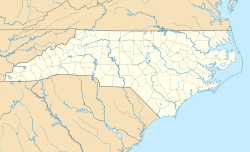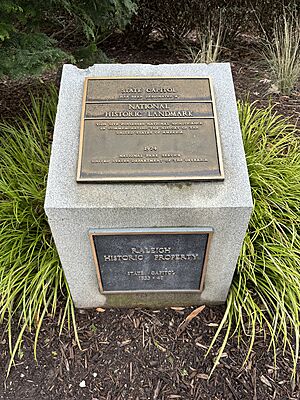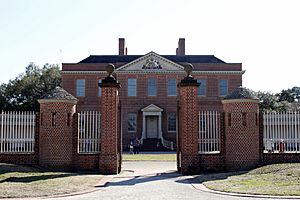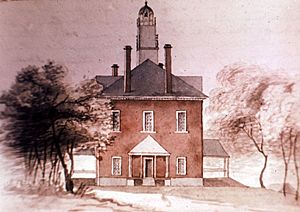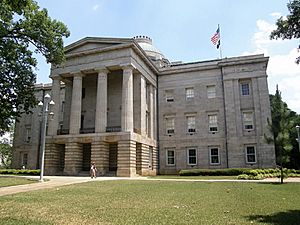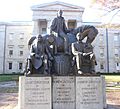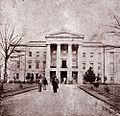North Carolina State Capitol facts for kids
|
North Carolina State Capitol
|
|
|
U.S. Historic district
Contributing property |
|
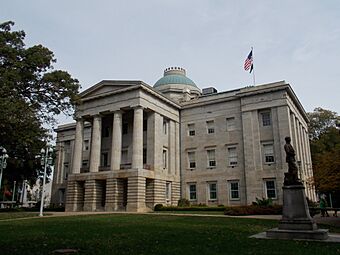 |
|
| Location | 1 E Edenton St, Raleigh, North Carolina |
|---|---|
| Built | 1833 |
| Architect | Multiple |
| Architectural style | Greek Revival |
| Part of | Capitol Area Historic District (ID78001978) |
| NRHP reference No. | 70000476 |
Quick facts for kids Significant dates |
|
| Added to NRHP | February 26, 1970 |
| Designated NHL | November 6, 1973 |
| Designated CP | April 15, 1978 |
The North Carolina State Capitol is a very important building in Raleigh, North Carolina. It used to be where all of North Carolina's state government worked. This included the lawmakers (the North Carolina General Assembly), the highest court (the Supreme Court), and the State Library.
Over time, different parts of the government moved to other buildings. The Supreme Court and State Library moved in 1888. The General Assembly, which makes the state's laws, moved to the North Carolina State Legislative Building in 1963. Today, the Governor of North Carolina and their team still have offices on the first floor of the Capitol building.
Contents
History of the Capitol Building
The current Capitol building was built after the first state house burned down in 1831. It is located in Raleigh, the state capital. The building is on Union Square at One East Edenton Street.
Building Design and Construction
The first stone of the Capitol was laid on July 4, 1833. This was done with special ceremonies by the Masonic group in North Carolina. The building was finished in 1840. Its design is in the Greek Revival style, which means it looks like ancient Greek temples.
Many architects worked on the Capitol's design. These included William Nichols Sr. and Jr., and the famous team of Ithiel Town and Alexander Jackson Davis. David Paton also played a big part in its final look.
Changes Over Time
The Capitol was home to the entire state government until 1888. The North Carolina General Assembly met there until 1961. In 1933, another special ceremony took place to mark 100 years since the first stone was laid.
The state lawmakers moved to their new building in 1963. The North Carolina Supreme Court has also used the Capitol. They even met there in 2005 when their own building was being fixed. The Governor and their staff have always kept offices in the Capitol.
The building looks much like it did in 1840. Only a few rooms have changed. Some committee rooms were divided to add restrooms. An elevator was put in one office in 1951, which changed that space a little.
The Capitol was named a National Historic Landmark in 1973. This means it's a very important historical place in the United States. It is also part of the larger Capitol Area Historic District.
The first group of lawmakers to meet in this building was the 63rd North Carolina General Assembly. They met there starting November 16, 1840. The last group to meet there was the 124th General Assembly, from February to June 1961.
In 2020, after protests for fairness and equality, Governor Roy Cooper ordered a large statue to be moved from the Capitol grounds. This statue honored the Confederacy.
Starting in 2023, the Capitol building's roof, including its dome, began to be repaired. This project cost $10 million to make sure the building stays in good shape.
North Carolina's Lawmaking Buildings
North Carolina's lawmakers have met in several places over the years. They might have first met at Tryon Palace after the British left in 1776. Then, they met in different spots until a special building for the state government was built in Raleigh in 1794.
That first building burned down in 1831. The North Carolina State Capitol building then became the home for lawmakers from 1840 to 1961. Today, they meet in the North Carolina State Legislative Building.
| Name | First Occupied (Assembly) | Last Occupied (Assembly) | Picture |
|---|---|---|---|
| Tryon Palace | 1777 (1st) | 1777 | |
| North Carolina State House | 1794 (19th) | 1810 (35th) | |
| Renovated North Carolina State House | 1811 (36th) | 1831 (55th) | |
| North Carolina State Capitol | 1840 (63rd) | 1961 (124th) | |
| North Carolina State Legislative Building | 1963 (125th) | still in use |
Statues and Art at the Capitol
Inside the Capitol's main round room, called the rotunda, there is a statue of George Washington. This statue is a copy of an older one that was destroyed in the 1831 fire. You can also see a bust (a sculpture of a head and shoulders) of John Motley Morehead, who was a governor of North Carolina.
Outside the Capitol, there are more statues. On the south side, there is another statue of George Washington. On the east side, you'll find statues of three U.S. Presidents who were from North Carolina: James Knox Polk, Andrew Jackson (on a horse), and Andrew Johnson. The Capitol grounds also have statues honoring women from the Confederacy, and veterans of the Civil War and the Viet Nam War.
See also
 In Spanish: Capitolio del Estado de Carolina del Norte para niños
In Spanish: Capitolio del Estado de Carolina del Norte para niños
- List of North Carolina state legislatures
- List of National Historic Landmarks in North Carolina
- National Register of Historic Places listings in Wake County, North Carolina
- List of state and territorial capitols in the United States


